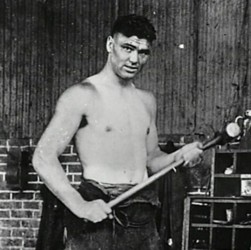 By Mike Dunn – Was it a legitimate title defense or just an exhibition that was termed a title defense? No one cay say definitively.
By Mike Dunn – Was it a legitimate title defense or just an exhibition that was termed a title defense? No one cay say definitively.
The fact is that Jack Dempsey, the heavyweight champion of the world, had an “official” four-round bout against an opponent named Jimmy Darcy on July 22, 1922, in Buffalo’s Broadway Auditorium. Dempsey, boxing in a “masterly fashion” according to a report in the San Francisco Chronicle the following day, won easily.
But was this bout, though it was recognized in New York State as a professional encounter, really for the title?
The Chronicle reporter apparently thought so. In his article, he made a point of saying the fight was indeed a title defense, noting that Darcy – a stablemate of Dempsey’s who was on tour with the champ at the time – would have wrested the title from the Manassa Mauler with a “lucky punch.”
Since that didn’t happen, the issue never came up and one can only speculate about who would have been champ if Darcy had indeed scored a shocking upset..
Dempsey had no intention of putting the title on the line when he went to the auditorium in Buffalo that summer night. He was on tour, as noted before, and was entertaining crowds across the country with exhibitions. In fact, he was scheduled to do three four-round exhibitions that very night.
Before he entered the ring, though, Dempsey received a telegram from the local office of the New York Boxing Commission informing that he would only be permitted to have one fight that night and it would not be classified as an exhibition. It would go to a decision and be considered an official fight.
Given those conditions and not wanting to disappoint the crowd, Dempsey complied by taking on Darcy, also known as Little Jimmy, who came into the ring with a reported record of 40-33-32 (including many no-decision bouts).
Little Jimmy, a native of Bucharest, Romania, had fought mostly as a middleweight and lightheavyweight and had been in against the best of his day. He had the distinction, in fact, of having knocked down both Harry Greb and Tommy Loughran with sharp rights, though Darcy was not as a particularly vicious puncher.
Little is known of the details of the fight between Dempsey and Darcy except that Dempsey dominated the action and there was no dispute at all about the decision.
This is how the Chronicle described it: “The champion took no chances on any adverse decision being given, the advices from Buffalo state, and boxed in a masterly fashion for the four rounds. At the conclusion the decision was his by a wide margin.”
Secretary Harry Burchell of the New York Boxing Commission is quoted in the Chronicle as saying, “Of course the bout had to be a decision. We had to see that the law was upheld. We make no distinction between exhibitions and regulation contests, according to law.”
So the law was upheld and Dempsey’s exhibition turned into an official encounter.
Does that mean Darcy’s name should be included among those of Bill Miske, Bill Brennan, Georges Carpentier and the other men who challenged Dempsey for the crown?
In the boxrec.com web site, it says beneath the Dempsey-Darcy result: “NYSAC World Heavyweight Title.” That’s about as good a way to put a tag on the fight as any.
Here’s some info about Darcy. His given name was Valen Trambitas and he took up residence in Portland, Ore. after coming ti the U.S. with his family in 1907. He was born in Romania on June 6, 1898.
Valen, who adopted the name Jimmy Darcy in honor of the late Australian middleweight Les Darcy, was one of three boxing Trambitas brothers. Alex and Johnny were actually considred to be better fighters than Valen!
Little Jimmy’s final ring record of 52-72-42 reveals an active if not successful fighter with a chin of granite. He scored 16 KO’s among his 52 wins but was only knocked out eight times in 72 defeats. And, of course, he has the distinction of going against the heavyweight champion of the world in a Buffalo ring in 1922 in an official contest, whether the heavyweight title was truly on the line that July night or not.
Mike Dunn is a writer and boxing historian living in Lake City, Mich.